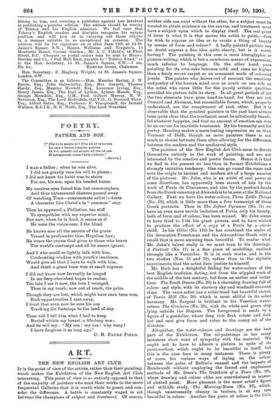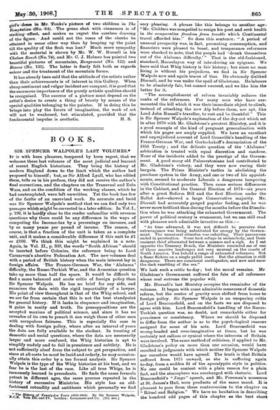ART.
THE NEW ENGLISH ART CLUB.
IT is the point of view of the artists, rather than their painting, which makes the Exhibition of the New English Art Club interesting. This point of view is so entirely opposed to that of the majority of painters who send their works to the more frequented Galleries that it is worth while to pause and con- sider the difference. A battle is constantly waged in art between the champions of subject and treatment. Of course, neither side can exist "without the other, for a subject must be treated to attain existence on the canvas; and treatment must have a subject upon which to display itself. The real point at issue is what it is that moves the artist to paint,—does he wish to express an idea or to create a thing of beauty by means of form and colour ? A badly painted picture can no doubt express a fine idea quite clearly, but is it worth having ? The painting in this case is mere hieroglyphic or picture-writing, which is but a cumbrous means of expression, much inferior to language. On the other hand, pure painting for its own sake becomes cold, and rises no higher than a finely woven carpet or an ornament made of coloured jewels. The painter who leaves out of account the emotions and poetry of the human mind errs as much on one side as the artist who cares little for the purely artistic qualities provided his picture tells its story. In all great periods of art the two elements have gone hand-in-hand, for they are not Ormuzd and Ahriman, but reeoncilable forces, which, properly understood, are the complement of each other. But it is observable that the greatest, painters in the past have always been quite clear that the treatment must be artistically beauti- ful whatever happens, and that no amount of emotion can ever be an excuse for inartistic treatment. By his humanity and his poetry, Memling makes a more kiting impression on us than Vermeer of Delft, though as mere painters there is not much to choose between them after allowing for the difference between the modern and the mediaeval style.
The painters of the New English Art Club seem to devote themselves entirely to the work of painting, and are not interested by the creative and poetic forces. Hence it is that we find in the present no less than in former Exhibitions a strongly imitative tendency. One can go round the room and note the origin in ancient and modern art of a large number of the pictures. Mr. John, who is an artist of real power in some directions, has apparently been struck of late by the work of Pavia de Chavannes, and also by the portrait-heads from the Greek cemetery at Alexandria to be seen at the National Gallery. First we have the water-colour, Three Little Things (No. 10), which is little more than a free transcript of these Greek portraits. Then in The Infant Pyramus (No. 71) we have an even more servile imitation of Pavia, only his beauty, both of form and of colour, has been missed. Mr. John seems to have tried to bide his great powers, and to have wished to produce the effect of a copy of a Puvis by a clever child. In his Olilai (No. 116) he has combined the styles of the decorative Frenchman and the Alexandrine Greek with a result that is more amusing than beautiful. To realise what Mr. John's talent really is we must turn to his drawings. A Portrait (No. 17) is a fine piece of modelling, realised strongly like a Verocchio. It is in such works, and in the two studies (Nos. 15 and 19), rather than in the stylistic experiments, that the artist does Justice to himself.
Mr. Rich has a delightful feeling for water-colour of the best English tradition, dating, not from the stippled work of the middle of the last century, but from an earlier and better time. The South Downs (No. 20) is a charming drawing full of colour and style, with its showery sky and windmill-crowned slope. The same artist has a sober-hued but beautiful sketch of Tewin Mill (No. 38) which is most skilful in its sober harmony. Mr. Sargent is brilliant in his Venetian water- colour, The Giudecca (No. 35), with its white and green ship lying outside the Dogana. The foreground is made by a figure of a gondolier, whose deep rich fle.sh colour and dark hat and coat give force and value to the sunny air of the distance.
Altogether, the water-colours and drawings are the best part of the Exhibition. The oil-paintings in too many instances show want of sympathy with the material. We ought not to have to admire a picture in spite of its paint-surface, • which ought to be beautiful in itself, but this is the case here in many instances. There is plenty of room for various ways of laying on the colour between the poles of Bellini's enamel and the impost() of Rembrandt without employing the forced and unpleasant methods of Mr. Steer's The Outskirts of a Town (No. 99), where drawing and colour alike are overwhelmed in masses of clotted paint. More pleasant is the same artist's figure and still-life study, The Morning-Room
(No. 87), which,
though unnecessarily clumsy in texture, is at any rate beautiful in colour. Another fine piece of colour is the litto girre lames in Mr, Tonks's picture of two children in The raseptetion-4No. 44). • The green shoe with -cinnamon is _ of striking effect, and makes us regret the careless drawing of -the rfigure.- -And could not the roses of the cheeks be attained in some other way than by heaping up the paint till the quality of the flesh was lost ? Much more sympathy with the material is shown by- Mr. W. W. Russell in his -Chelsea Reach (No. 74), and Mr. C. J. Holmes has painted two beautiful pictures of mountains, Rougement (No. 122) and Biasca(No. 135). The latter is finely felt both as regards eelour and the treatment of the mountain forms.
• It has already been said that the attitude of the artists rather than their achievements is of interest in this Gallery. When cheap sentiment and vulgar incident are rampant, it is good that the enormous importance of the purely artistic qualities should be recognised. The success of a picture must depend on the artist's desire to create a thing of beanty by means of the special qbalities belonging to the painter. If in doing this he brings into plaY' the forces of ' imagination, the work of art will not be weakened, but stimulated, provided that the
fundamental impulse is aesthetic. H. S.







































 Previous page
Previous page